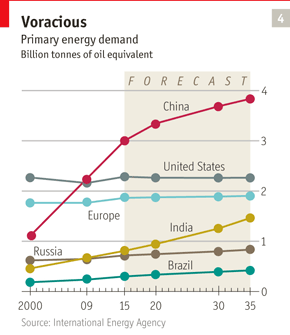Chart of the day: Flat-liners versus climbers on L.T. energy demand
 Tuesday, January 31, 2012 at 11:24AM
Tuesday, January 31, 2012 at 11:24AM  From an otherwise regurgitating Economist special report on state capitalism, a wonderfully clear chart on primary energy demand, aggregated as billion tons of oil equivalent.
From an otherwise regurgitating Economist special report on state capitalism, a wonderfully clear chart on primary energy demand, aggregated as billion tons of oil equivalent.
Not amazing: semi-flat growth for Russia, given its demographic slide.
Impressive for US and EU: the efficiency angle keeping growth flat, despite modest economic growth and significant demographic growth for US.
Curious is Brazil's capacity to keep its curve semi-flat.
So that leaves only the two great risers as demand climbers: China's stunning trajectory and India's late-blooming-but-likely-to-skyrocket-from-that-point-on curve (India surpasses China in labor around 2030 and then grows 50% larger, suggesting it will replicate China's trajectory on some level, understanding that its energy profile could be dramatically different in those future decades).
To me, this is a great example of why the military containment strategy (keep the PLA boxed-in in East Asia is dangerous - and counterproductive. China needs to go so incredibly global due to its energy demand that it's only natural that it build up power projection and become more contentious on the issue of energy security. America can address all that or go super-unimaginative and make it all about an arms race in East Asia, believing that we'll temper China's behavior by doing the same things we did with the Sovs in the Cold War.
But making China feel nervous at home makes it harder for it to address its growing overseas dependencies in the very same regions where the U.S. is becoming less interested in providing stability and more focused on just killing bad guys. Conceivably, our willingness to go anywhere we want, when we want, to kill anybody we want, would make the Chinese feel better about their interests in these regions. But this thin-green-line approach, augmented with the transparent encirclement strategy in East Asia, essentially works to keep China nervous on both scores by insinuating that growing Chinese military capacity is automatically bad - both at home and extra-regionally, unless, of course, the Chinese become "transparent" in the direction of the very same superpower that threatens them in their home region with its world-class military (the same one that's just declared China to be its primary force-sizing threat from here on out).
Bit much, huh?
 Brazil,
Brazil,  China,
China,  EU,
EU,  India,
India,  Russia,
Russia,  US,
US,  energy | in
energy | in  Chart of the day |
Chart of the day |  Email Article |
Email Article |  Permalink |
Permalink |  Print Article
Print Article 









Reader Comments (2)
China needs to go global indeed! But to this point they are only going global in terms of fuel and raw materials supply. The operation of their industries is almost entirely in the hands of inefficient, unaccountable state-owned companies. The suppliers to these companies of equipment and engineering are almost entirely other Chinese state-owned companies whose major prowess is not their abilities but rather their connections (guanxi.) Engineering companies such as Bechtel and Black and Veatch have tiny offices in China doing work mostly for other foreign companies and outside of China. Some energy use increase in China is explained by economic growth, but much of the increase is also explained by a lack of innovation.
Wasn't the cold war as much about bankrupting the USSR via an arms race as much or more than it was about achieving military supremacy? Why won't the Chinese do the same to the US?